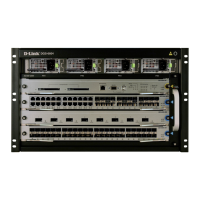DGS-6604 ipv6 router ospf area
CLI Reference Guide
368
ipv6 router ospf area
To enable IPv6 OSPF on an interface, use the ipv6 router ospf area command.
To disable IPv6 OSPF routing for interfaces defined, use the no form of this
command.
ipv6 router ospf area AREA-ID [tag PROCESS-ID] [instance-id INSTANCE-ID]
no ipv6 router ospf area AREA-ID [tag PROCESS-ID] [instance-id INSTANCE-ID]
Default IPv6 OSPF is disabled.
PROCESS-ID: null
INSTANCE-ID: 0
Command Mode Interface configuration
Usage Guideline Before enabling IPv6 OSPF on an interface using the ipv6 router ospf area
command, IPv6 must be enabled on the interface, and IPv6 routing must be
enabled on the switch. There is no limit to the number of ipv6 router ospf area
commands that can be used on the router. At least two interfaces must be
configured for IPv6 OSPF to run.
If the configuration is based on a specific process, then the no form of the
command must include the process information.
Example The following example enables IPv6 OSPF on an interface.
Syntax Description
AREA-ID The identifier of the area for which the vlan interface is to be enabled. It can be
specified as either a decimal value or as an IPv4 address.
PROCESS-ID (Optional) An internally used identification parameter for an IPv6 OSPF routing
process. It is locally assigned and can be any positive integer. A unique value is
assigned for each IPv6 OSPF routing process.
INSTANCE-ID (Optional) Instance identifier. To change this ID, configure the "no" command
first. The valid setting is from 0 to 255.
Switch > enable
Switch # configure terminal
Switch (config)# interface vlan1
Switch (config-if)# ipv6 router ospf area 0 instance-id 2

